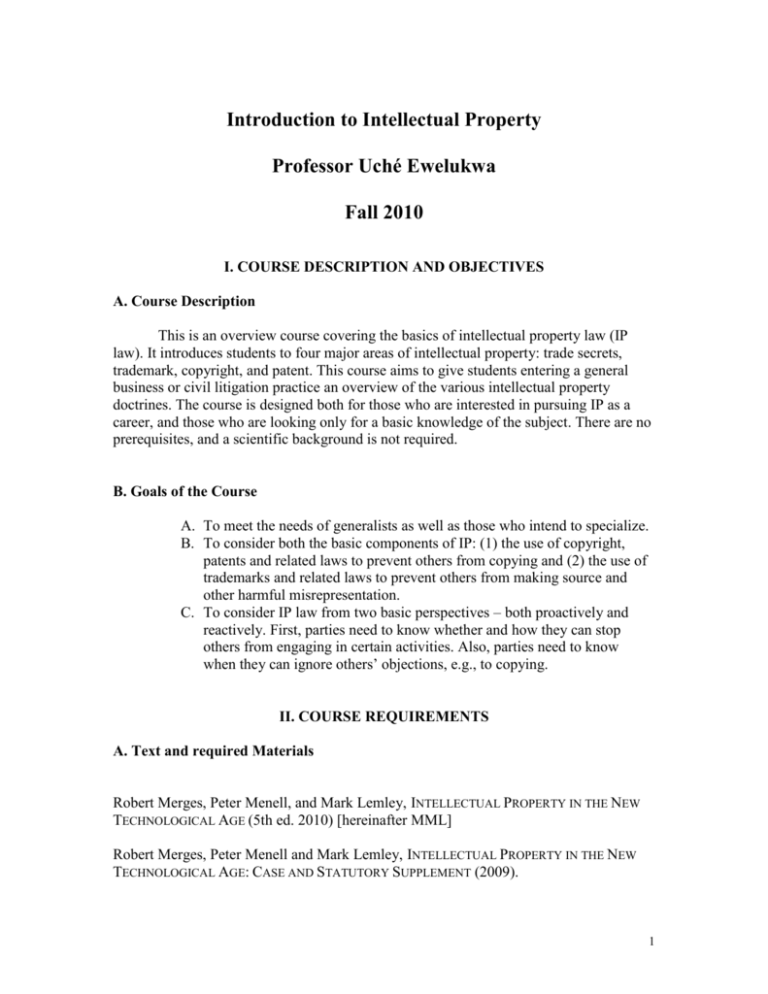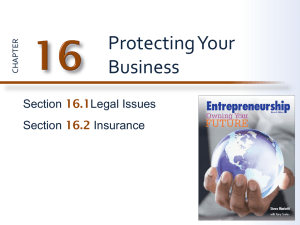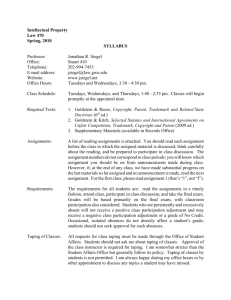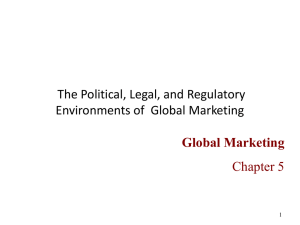syllabus: intellectual property law (7555-00)
advertisement

Introduction to Intellectual Property Professor Uché Ewelukwa Fall 2010 I. COURSE DESCRIPTION AND OBJECTIVES A. Course Description This is an overview course covering the basics of intellectual property law (IP law). It introduces students to four major areas of intellectual property: trade secrets, trademark, copyright, and patent. This course aims to give students entering a general business or civil litigation practice an overview of the various intellectual property doctrines. The course is designed both for those who are interested in pursuing IP as a career, and those who are looking only for a basic knowledge of the subject. There are no prerequisites, and a scientific background is not required. B. Goals of the Course A. To meet the needs of generalists as well as those who intend to specialize. B. To consider both the basic components of IP: (1) the use of copyright, patents and related laws to prevent others from copying and (2) the use of trademarks and related laws to prevent others from making source and other harmful misrepresentation. C. To consider IP law from two basic perspectives – both proactively and reactively. First, parties need to know whether and how they can stop others from engaging in certain activities. Also, parties need to know when they can ignore others’ objections, e.g., to copying. II. COURSE REQUIREMENTS A. Text and required Materials Robert Merges, Peter Menell, and Mark Lemley, INTELLECTUAL PROPERTY IN THE NEW TECHNOLOGICAL AGE (5th ed. 2010) [hereinafter MML] Robert Merges, Peter Menell and Mark Lemley, INTELLECTUAL PROPERTY IN THE NEW TECHNOLOGICAL AGE: CASE AND STATUTORY SUPPLEMENT (2009). 1 Intellectual Property Law Coursepacks (CP) [Available periodically from Administrative Secretary, Bridget Young.1 Handouts (distributed periodically in-class). B. Scheduled Class Times The class will meet Mondays, Tuesdays, and Thursdays from 9:10 am to 10:10 am in Room 103. Please arrive on time. C. Class Participation and Attendance Class sessions are a mixture of class discussion based on the reading assignment, analysis of hypotheticals, lecture, and debate on assigned cases. You should always come to class with your Case and Statutory Supplement. Students are expected to attend and participate in all sessions of the class. I will feel free to call on you to contribute even if you have not raised your hand. Students with disabilities may request academic adjustments as provided within federal law. All such requests should be made by first contacting the Center for Students with Disabilities. Additional information about the process may also be obtained from Associate Dean Miller. Contact information for the Center is as follows: ARKU 104 Fayetteville, AR 72701 (479) 575-3104 (voice) (479) 575-3346 (TTY) Ada@uark.edu Web: http://www.uark.edu/ua/csd/ D. Assignment Although most of the assignments involve reading assigned course materials, occasionally, students will be required to engage in real life practicals and to turn in written reports of their findings. In the past, for example, students were asked to interview local merchants who are owners or users of trademarks and service marks. E. Grading 1 Bjyoung@uark.edu or (479) 575-5318 2 The grade for the class will be based on a final 24-hour take-home examination. The examination will be administered December 13, 2010, through December 17, 2010. In addition, very high-quality participation will result in a half-grade increase (e.g. from B to B+, from B+ to A-, etc.). A student’s participation is considered high-quality if he or she points out key insights from assigned readings, and adds additional insights and perspectives that extend beyond the assigned readings to issues under discussion. More than five absences (late arrivals will count as absence) without the prior permission of the instructor will result in a half-grade decrease. F. Office Hours My office is located in Room 318. My scheduled office hours are on Thursdays from 3:00 p.m. to 5:00 p.m. In addition, you may feel free to stop by at any other time in my office, or to call to schedule an appointment. I am usually in my office Monday through Thursday from 8:00 am to 4:00 pm, except when I am in class. My office phone number is (479) 575-5283. You may also reach me via e-mail at uchee@uark.edu. G. Career and Study Abroad Advice Any time you need advice for a summer program, an LL.M. program, or want to talk about careers in intellectual property law, come and see me! H. Inclement Weather This class will NOT meet if Fayetteville Public Schools are closed because of inclement weather. F. When determining whether or not material will be covered on the exam please note the following two classifications: SKIM = Optional reading, may be discussed in class, may be covered on exam. SKIP = Optional reading, will NOT be on exam. III. USEFUL INTELLECTUAL PROPERTY-RELATED WEBSITES A. United States Patent and Trademark Office: http://www.uspto.gov/ B. United States Copyright Office: http://www.copyright.gov/ C. National Inventors Hall of Fame: http://www.invent.org/ D. IP Newsflash: http://www.ipnewsflash.com/ 3 E. International Trademark Association: http://www.inta.org/ F. World Intellectual Property Organization: http://www.wipo.int/portal/index.html.en G. World Trade Organization/ Agreement on Trade-Related Aspects of Intellectual Property: http://www.wto.org/english/tratop_e/trips_e/trips_e.htm H. The UK Patent Office: http://www.patent.gov.uk/ I. European Patent Office: http://www.european-patent-office.org/index.en.php IV. SYLLABUS The syllabus below provides a rough and working outline of the course. The syllabus sets forth the reading assignments from the course's primary text, Robert Merges, Peter Menell, and Mark Lemley, Intellectual Property in the New Technological Age (5th ed. 2010). Where a case or other materials refer to a state or federal statute, you are responsible for locating (in the Casebook Supplement) and reading the section(s) of the statute to which the text refers. Except where otherwise indicated, assignment of a case includes all “Comments and Questions” and the “Problems” that follow it. This syllabus is subject to change as the semester progresses. I reserve the right to make changes, delete certain readings and add others, as the course progresses. I may therefore be selecting additional and/or substitute readings, with plenty of time to read and prepare for class, on various issues as the course progresses, and as our collective interests evolve. I will periodically be distributing supplementary assignments in the form of handouts in class. [Page Numbers Are In Brackets After Each Major Section. Please read all the cases that appear in the assigned reading even if not specifically listed below.] Make-up classes: Professor Uche will be away November 18 (attending the biennial conference of the International Economic Law Interest Group of the American Society of International Law (ASIL)) and November 22 -29 (attending the 5th annual trade conference organized by the Trade Policy Training Center in Tanzania, Africa). As a class, we will have to discuss the best may to make-up the classes that will be missed. 4 Introduction Aug. 23: A. Theoretical Underpinning of Intellectual Property Law; Philosophical Perspectives [MML 1-14]; Merill Mattews, Jr. and Tom Giovanetti, Why Intellectual Property is Important, July 8, 2002; Steven E. Levingston, Dangers of over-zealous intellectual property cops, The Washington Post, February 24, 2010, http://voices.washingtonpost.com/shortstack/2010/02/dangers_of_overzealous_intell.html Natural Rights Perspective; John Locke, Two Treatises on Government; Problem; Personhood Perspective; Margaret Jane Radin, Property and Personhood; Utilitarian/Economic Perspective; Problem B. Overview of Intellectual Property [21-31] Trade Secret; Patent; Copyright; Trademark/Trade Dress; Problem. I. TRADE SECRET Aug. 24: A. Introduction [33-39]; Problems 1-2 and 1-3 History; Overview of Trade Secret Protection; The Uniform Trade Secret Act; Theory of Trade Secrets; B. Subject Matter [39-49]; Problem 2-1, 2-2, 2-3, 2-4, 2-5] Defining Trade Secrets; Metallurgical Industries Inc. v. Fourtek, Inc. Problem. Aug. 26 C. Reasonable Efforts to Maintain Secrecy [49-58] What counts as reasonable effort to protect secrecy? Rockwell Graphic Systems, Inc. v. DEV Industries, Inc.; Electro-Craft Corp. v. 5 Controlled Motion, Inc., Problems 2-6, 2-7 and 2-8. D. Disclosure of Trade Secrets [58-65] Data General Corp. v. Digital Computer E. Misappropriation of Trade Secrets [66-70] Improper Means; E.I. du Pont de Nemours & Co. v. Rolfe; Problem 2-8. August 30 [70-75; 78-83; 85-91; 91-100 (skim); 100-104] Breach of Confidential Relationship. Smith v. Dravo Corp. Problems 2-9, 2-10. Reverse Engineering. Kadant, Inc. v. Seeley Machine, Inc. Problem 2-12 and 2-13. The Special Case of Departing Employees. Note on Trailer Clauses.. Non-compete Agreements. SKIM; Edwards v. Arthur Andersen LLP.; Comprehensive Technologies Intl. v. Software Artisans., Inc.; Inevitable Disclosure of Trade Secrets. August 31 F. Agreement to Keep Secret [107-111] Problem 2-15; Warner-Lambert Pharmaceutical co. v. John J. Reynolds, Inc. G. Trade Secret Protection on Arkansas [CP 1-14] The Arkansas Trade Secret Act (ATSA). Saforo & Associates, Inc. v. Porocel.; Cardinal Freight Carriers, Inc. v. J.B. Hunt Transport Servs.; City Slickers, Inc. v. Douglas; Mark Lemley, Beyond Trade Secrets: Protecting Business Information in Arkansas I. TRADEMARK September 2 A. Introduction [733-736; 740-764] Background; A Brief Overview of Trademark Theory; The Basic Economics of Trademarks and Advertising; What can be Protected as a Trademark? 6 15 U.S.C. § 1127, 1053, 1054 B. What Can be Protected as a Trademark? Qualitex Co. v. Jacobson Products Co.; 15 U.S.C. § 1127, 1052. C. Categories of Marks Service, Certification and Collective Marks 15 U.S.C. § 1053, 1054 D. Establishment of Rights 1. Distinctiveness Classification and Requirements; Zatarain’s, Inc. v. Oak Grove Smokehouse, Inc. Sept. 6: No Class. Labor Day Sept. 7 2. Priority [777-788; 793-796;] Zazu Designs v. L’Oreal; Note on Geographic Limitations; Note on Secondary Meaning in the Making; Problems 5-3 and 5-4; Assignment. 15 U.S.C. §1063, 1064, 1065, 1068 3. Trademark Office Procedures [796-800] The Registration Process; Principal vs. Supplemental Register; Use Application v. Intent-to-Use Application; Problem 5-5 15 U.S.C. § 1051, 1057, 1058, 1059. Sept. 9: 3. Trademark Office Procedures (Contd.) [801-810]; CP [20-43] Geographic Markets. In re Nantucket, Inc.; Lanham Act § 2(a); Marks Which are "Primarily Merely a Surname; Opposition; Cancellation; Concurrent Registration. Problem 5-6. 7 15 U.S.C. § 1052, § 1062-1068 4. Incontestability [810-816] Park ‘N Fly, Inc. v. Dollar Park and Fly, Inc. Sept. 13: E. Infringement: What Rights are Encompassed by Ownership? 1. Likelihood of Consumer Confusion [824-838] AMF Inc. v. Sleekcraft Boats; Note on Other Types of Confusion; Problems 5-7; 58. 15 U.S.C. § 1114, 1125(a). 2. Dilution [838-852] The New Federal Regime; H.R. Rep. 104374; Basic Principles; Louis Vuitton Malletier S.A. v. Haute Diggity Dog, LLC. 15 U.S.C. § 1125(c)(1). Sept. 14: In-Class Presentation of Assignment Sept. 16: F. Defenses: Losing Protection 1. Genericness [890-897] The Murphy Door Bed Co. v. Interior Sleep Systems. Problem 5-11. 2. Functionality [900-910] TrafFix Devices, Inc. v. Marketing Displays, Inc.; Restatement (Third) of Unfair Competition § 17; Problem 5-12, 5-13. Sept. 20: 3. Abandonment 911-918; 919-923; 925-929 8 Major League Baseball Properties v. Sed Non Olet Denarius; Dawn Donut Company, Inc. v. Hart’s Food Stores, Inc. 4. Fair Use KP Permanent Make-up, Inc. v. Lasting Impression I, Inc. Problems 5-14 and 5-15. Sept. 21 4. Nominative Use [929-940] Mattel, Inc. v. MCA Records; Problems 516, 5-17, 5-18] III. COPYRIGHT A. Introduction [411-419] Brief History of Copyright Protection Overview of Copyright Regime Philosophical Perspectives on Copyright Protection; Registration Forms. 17 U.S.C. § 101, 401-412, 708 Sept. 23 B. Requirements Introduction; 17 U.S.C. § 102, 103, 105 1. Originality and Fixation [420-432] H.R. Rep. No. 94-1476 (1976); Feist Publications v. Rural Telephone Service; Problems 4-1, 4-2. 2. Formalities [435-440] Notice; Publication; Problem; Registration; Deposit; Note on Restoration of Foreign Works. C. Exclusions 1. Idea and Facts vs. Expression; The Merger Doctrine [441-446] 9 17 U.S.C. § 102(b); Baker v. Selden. Problem 4-4 Oct. 4: Idea and Facts vs. Expression (contd.) [448-462] Lotus Development Corp. v. Boland International; Morrissey v. Proctor & Gamble 2. Government Works [473-478] D. The Domain and Scope of Copyright Protection 1. Subject Matter of Copyright [478-487]; Problems 4-14, 4-15, and 4-16 17 U.S.C. § 101, 102 & 103. Oct. 5 E. Ownership & Duration 1. Initial Ownership [487- 506] Works for Hire; Community for Creative Non-Violence v. Reid; Joint Works; Aalmuhammed v. Lee; Collective Works; Problems 4-17, 4-18, 4-19, 4-20 17 U.S.C. § 101, 201-202 Oct. 7 [508-537] 2. Duration and Renewal [508-516] Problems 4-21; 4-22; 4-23 17 U.S.C. § 302-05 E. Exclusive Rights 17 U.S.C. § 106, 106A, 501(a) & (b), 113(d) 1. Reproduction [518-537] Copying; Arnstein v. Porter; Problem; Improper Appropriation; Nichols v. 10 Universal Pictures Corp.; Problems 4-25, 426, 4-27, 4-28. Oct. 11: Reproduction [539-556] Computer Associates International v. Altai, Inc. Problems 4-29 and 4-30. Oct. 12 2. Derivative Works [557-567] Anderson v. Stallone; Problems 4-31, 4-32, 4-33 3. Public Performance and Display Rights [571-577]; Problems 4-35, 4-36, 4-37 Oct. 14: F. Defenses 1. Fair Use [592-611; 611-619] 17 U.S.C. § 107; Harper & Row Publishers v. Nation Enterprises; Sony Corp. of America v. Universal City Studios; Problem 4-39; 4-40; 4-41; 4-42. Oct. 18 [622-633; 635-641] Parodies. Campbell v. Acuff-Rose Music, Inc.; Problems 4-43, 4-44, 4-45; Bill Graham Archives v. Dorling Kindersley Ltd. Oct. 19 [641-665] Blanch v. Koons; Sega Enterprises Ltd. v. Accolade, Inc. Problems 4-46; 4-47. H. Remedies [722-732] Problems 4-51, 4-52, 4-53, and 4-54 IV. PATENTS 11 Oct. 21: A. Introduction [130-146] CP [140-179] An Overview of Patent Law; Notes on the Procedures for Obtaining a Patent; Theories of Patent Law. B. The Elements of Patentability 1. Patentable Subject Matter Diamond v. Chakrabarty; Parke-Davis & Co. v. H.K. Mulford Co.; Bilski v. Kappos (handout to be distributed). Problems 3-2, 3-3, 3-4. Oct. 25: [166-171, 178-185; 185-190] 2. Utility Patent law’s definition of utility. Brenner v. Manson; Juicy Whip, Inc. v. Orange Bang, Inc. Problem 3-5. 3. Disclosure Doctrines Enablement Requirement. The Incandescent Lamp Patent. Problem 3-6 October 26. [195-200; 209-214; 216-225] 4. Novelty and Statutory Bars The Nature of Novelty; Rosaire v. National Lead Co. Problems 3-8. Statutory Bars: Publications; In re Hall Statutory Bars: Public Use; Egbert v. Lippmann; Problem 3-9 October 28 & Nov. 1 [226-234; 235-246; 247-267] The Experimental Use Exception; City of Elizabeth v. Pavement Company Priority Rule and the First to Invent 12 Griffith v. Kanamaru. 5. Nonobviousness Graham v. John Deere Co.; Combining References. KSR International Co. v. Teleflex Inc. Nov. 2 C. Infringement 1. Literal Infringement [294-299] Larami Corp. v. Amron 2. The Doctrine of Equivalents [300-327] Warner-Jenkinson Company, Inc. v. Hilton Festo Corp. v. Shoketsu Kinzoku Kogyo Subject Matter Disclosed but Not Claimed; Johnson & Johnson Associates Inc. v. R.E. Services Problem 3-12. Nov. 4 3. Contributory Infringement; Joint Infringement [334-342] C.R. Bard, Inc. v. Advanced Cardiovascular Systems, Inc.; Note on Inducement; Problem 3-13. D. Defenses [343-346]; [347-352] 1. The “Experimental Use” Defense [343-346] Madey v. Duke University; Merck KGaA v. Integra Life Sciences I Ltd. 2. Inequitable Conduct [347-352] Kingsdown Medical Consultants, Ltd. v. Hollister Inc. 13 Nov. 4: [353-359; 377-392; 393-398] 3. Exhaustion of Patent Rights Quanta Computer, Inc. v. LG Electronics, Inc. Problem 3-14 F. Remedies & Conclusion 1. Injunctions eBay, Inc. v. MercExchange, LLC 2. Damages: Reasonable Royalty and Lost Profits 3. Willful Infringement In re Seagate Technology, LLC. V. Integrated Workshop I: Industrial Designs and Intellectual Property Nov. 8: Trademark and Design [764-774] Two Pesos, Inc.v Taco Cabana, Inc.; Wal-Mart Stores, Inc. V. Samara Brothers, Inc. What is a trade dress? Are trade dress protected? Is secondary meaning required to protect trade dress? Nov. 9: Copyrights and Designs [463-473]; Photocopied materials (TBD) The Useful Article Doctrine. Challenges to Using Copyright to Protect Designs. Bandir International, Inc. v. Cascade Pacific Lumber Co. Nov. 11, 15, 16: Design Patents Photocopied Materials (TBD) VI. Integrated Workshop II. Intellectual Property and International Law Workshop seeks to seeks to explore and enhance the understanding of (1)intellectual property protection in multiple jurisdictions and cultures, (2) multilateral treaties that provide for the protection of intellectual property, (3) the problem of piracy in developing countries and challenges to IP enforcement. 14 Dates: Nov. 18 & 29 Reading Assignment: TBD VII. Integrated Workshop III: Intellectual Property, Entertainment and Sports Law Workshop seeks to seeks to explore and enhance the understanding of (1) principals and information in the fields of intellectual property, entertainment and sports law, (2) some of the means by which rights in these fields can be protected, (3) some state and federal relative to these fields, and (4) protection of the rights of individuals and businesses in these fields. Dates: November 30 and December 2. Reading Assignment: TBD 15









